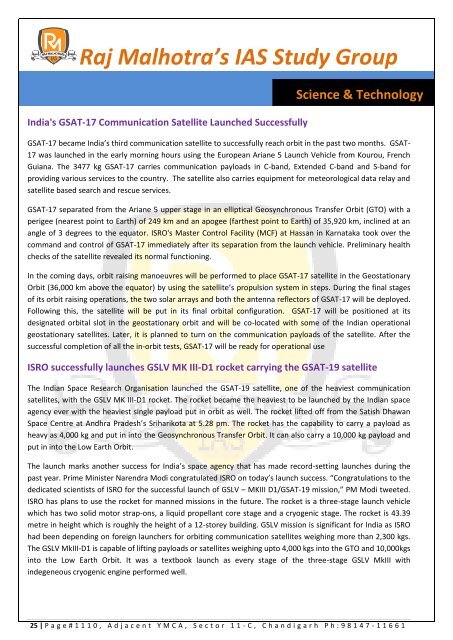You also want an ePaper? Increase the reach of your titles
YUMPU automatically turns print PDFs into web optimized ePapers that Google loves.
Raj Malhotra’s IAS Study Group<br />
India's GSAT-17 Communication Satellite Launched Successfully<br />
Science & Technology<br />
GSAT-17 became India’s third communication satellite to successfully reach orbit in the past two months. GSAT-<br />
17 was launched in the early morning hours using the European Ariane 5 Launch Vehicle from Kourou, French<br />
Guiana. The 3477 kg GSAT-17 carries communication payloads in C-band, Extended C-band and S-band for<br />
providing various services to the country. The satellite also carries equipment for meteorological data relay and<br />
satellite based search and rescue services.<br />
GSAT-17 separated from the Ariane 5 upper stage in an elliptical Geosynchronous Transfer Orbit (GTO) with a<br />
perigee (nearest point to Earth) of 249 km and an apogee (farthest point to Earth) of 35,920 km, inclined at an<br />
angle of 3 degrees to the equator. ISRO's Master Control Facility (MCF) at Hassan in Karnataka took over the<br />
command and control of GSAT-17 immediately after its separation from the launch vehicle. Preliminary health<br />
checks of the satellite revealed its normal functioning.<br />
In the coming days, orbit raising manoeuvres will be performed to place GSAT-17 satellite in the Geostationary<br />
Orbit (36,000 km above the equator) by using the satellite’s propulsion system in steps. During the final stages<br />
of its orbit raising operations, the two solar arrays and both the antenna reflectors of GSAT-17 will be deployed.<br />
Following this, the satellite will be put in its final orbital configuration. GSAT-17 will be positioned at its<br />
designated orbital slot in the geostationary orbit and will be co-located with some of the Indian operational<br />
geostationary satellites. Later, it is planned to turn on the communication payloads of the satellite. After the<br />
successful completion of all the in-orbit tests, GSAT-17 will be ready for operational use<br />
ISRO successfully launches GSLV MK III-D1 rocket carrying the GSAT-19 satellite<br />
The Indian Space Research Organisation launched the GSAT-19 satellite, one of the heaviest communication<br />
satellites, with the GSLV MK III-D1 rocket. The rocket became the heaviest to be launched by the Indian space<br />
agency ever with the heaviest single payload put in orbit as well. The rocket lifted off from the Satish Dhawan<br />
Space Centre at Andhra Pradesh’s Sriharikota at 5.28 pm. The rocket has the capability to carry a payload as<br />
heavy as 4,000 kg and put in into the Geosynchronous Transfer Orbit. It can also carry a 10,000 kg payload and<br />
put in into the Low Earth Orbit.<br />
The launch marks another success for India’s space agency that has made record-setting launches during the<br />
past year. Prime Minister Narendra Modi congratulated ISRO on today’s launch success. “Congratulations to the<br />
dedicated scientists of ISRO for the successful launch of GSLV – MKIII D1/GSAT-19 mission,” PM Modi tweeted.<br />
ISRO has plans to use the rocket for manned missions in the future. The rocket is a three-stage launch vehicle<br />
which has two solid motor strap-ons, a liquid propellant core stage and a cryogenic stage. The rocket is 43.39<br />
metre in height which is roughly the height of a 12-storey building. GSLV mission is significant for India as ISRO<br />
had been depending on foreign launchers for orbiting communication satellites weighing more than 2,300 kgs.<br />
The GSLV MkIII-D1 is capable of lifting payloads or satellites weighing upto 4,000 kgs into the GTO and 10,000kgs<br />
into the Low Earth Orbit. It was a textbook launch as every stage of the three-stage GSLV MkIII with<br />
indegeneous cryogenic engine performed well.<br />
25 | P a g e # 1 1 1 0 , A d j a c e n t Y M C A , S e c t o r 1 1 - C , C h a n d i g a r h P h : 9 8 1 4 7 - 1 1 6 6 1





